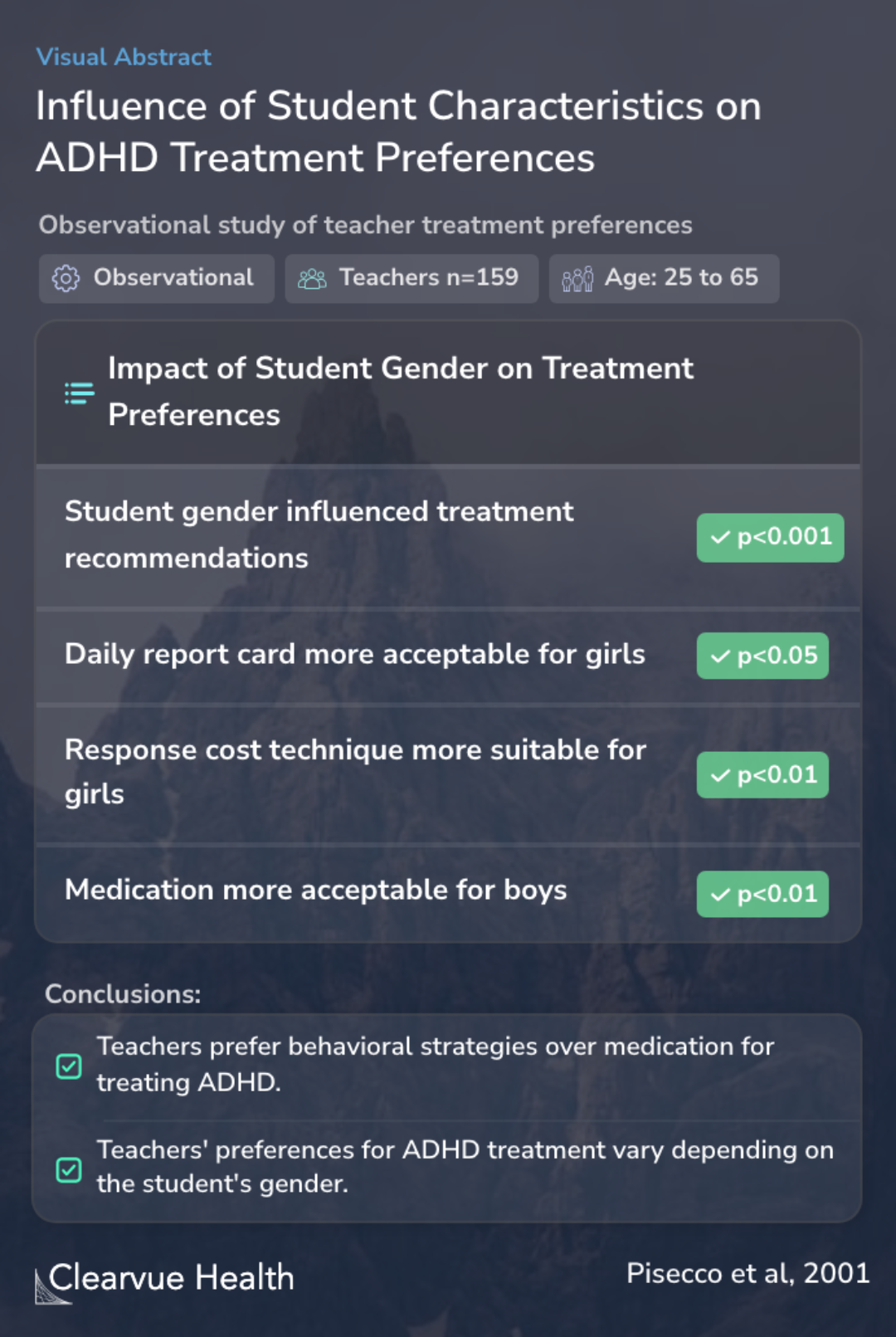The effect of child characteristics on teachers' acceptability of classroom-based behavioral strategies and psychostimulant medication for the treatment of ADHD
Teachers' Acceptance of ADHD Treatments Based on Child Characteristics
Pisecco S, Huzinec C, Curtis D

Objectives
The study aimed to explore how student characteristics like sex and symptoms influence teachers' opinions about different ways to manage ADHD (Attention Deficit Hyperactivity Disorder). The goal was to see what teachers thought about various treatments in terms of how acceptable, effective, and timely they were.
Studied the effect of student characteristics on teachers' ratings of treatment acceptability for attention deficit hyperactivity disorder (ADHD).
Methods
The participants in the study were 159 seasoned elementary school teachers. They reviewed detailed scenarios (vignettes) of children with typical ADHD symptoms. These scenarios were carefully designed to be consistent in how they described the symptoms but varied in the child's sex and specific type of ADHD symptoms.
The teachers then learned about several treatment strategies including a daily report card (DRC), a response cost technique, a classroom lottery, and medication. After reviewing these methods, they used a tool called the Behavioral Intervention Rating Scale to share their views on these treatments.
Participants (N = 159) included experienced elementary school teachers who read 1 of 6 vignettes describing a child with symptoms representative of ADHD. Vignettes varied by sex and symptom-subtype classification. However, the number and specific type of symptoms described in the vignett...
Results
The results showed that teachers generally found the daily report card (DRC) method to be more favorable than other treatments across the board. However, the study found that the teachers' preferences were influenced by the student's sex. Notably, certain treatments like the daily report card and response cost technique were more preferred for girls, while medication was viewed more favorably for boys. These findings underline how teachers may vary their treatment recommendations based on the gender of the student.
Teachers preferred the DRC to all other forms of treatment. However, there was a significant interaction between the type of treatment and sex of the student on the 3 factors (Treatment Acceptability, Treatment Effectiveness, and Timeliness) of the BIRS.
Evidence Comparison
The study's findings mirror established recommendations from major health organizations like the American Academy of Pediatrics and the Centers for Disease Control and Prevention, which emphasize the value of behavioral therapies. These therapies, such as Parent Training in Behavior Management, are particularly underscored for young children as a first-line treatment. The study aligns with these practices by highlighting the preference for behavioral strategies over medication.
Further, the study's acknowledgment of medication as a part of comprehensive ADHD management reflects the guidance that suggests pharmaceutical options, such as methylphenidate, should be considered when behavioral interventions alone prove inadequate. This is a consistent approach seen across different age groups, emphasizing a tailored treatment strategy that adjusts to the unique needs of each child.
Conclusions
In the study, teachers often chose methods based on behavior to help students with ADHD, rather than using medication. They sometimes made different choices depending on if the student was a boy or a girl.
Teachers showed a preference for behavioral strategies over medication for treating ADHD in students, with a noted variance according to the child's sex.
Key Takeaways
Context
For readers interested in exploring how ADHD treatment preferences might differ by gender, the article by Levy et al. offers deeper insights. It discusses the nuanced differences in ADHD and its accompanying conditions like anxiety and conduct disorder, providing gender-specific perspectives that could influence tailored treatment strategies.
Another intriguing read is an article that examines the impact of gender on social skills in children with ADHD. It challenges some established notions by showing that ADHD affects social skills similarly in both genders. Nevertheless, it also highlights that girls with ADHD often perceive themselves as more empathetic, which may guide specific therapeutic approaches.